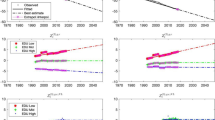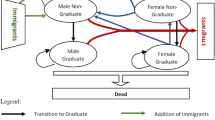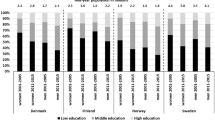Abstract
Educational attainment is an attribute that leads to a great distinction between the members of a population, including when considering their health and well-being, which are features to pursue within an aging society. The aim of this work was to produce demographic projections for the Portuguese population by sex, age group and level of educational attainment, for the period 2011–2031. Considering fertility, mortality and migration differentials by level of education, the population was projected using the multistate cohort-component method with a block Leslie matrix. Two scenarios were considered, one where educational attainment before 2011 remains constant and another in which educational attainment will follow the trend observed over the last decade, being the trend in the state proportion modelled using continuation ratio models. The results show an increase in the proportion of individuals who complete higher educational levels in almost all age groups of both sexes. Among women, only 13.6 % had completed some level of higher education in 2011, a figure that will rise to approximately 23.4 % in 2031, whereas among men this value was only 9.7 % and will also rise by 2031, reaching 15.5 %. We can expect the proportion of people with higher educational levels to continue to rise as the education of younger cohorts seems to evolve positively. This work will be particularly useful to study how the aging population and the rising levels of education can contribute to the planning and monitoring of public policies, although these findings can also be used in other research contexts.






Similar content being viewed by others
Notes
Dustmann and Glitz (2011) classify as deliberate migrations those due to individual decisions, based on seeking better economic conditions in other regions.
There are no published results from the projections produced by Statistics Portugal, concerning either age-specific fertility rates or infant mortality rates, which led to the need for using the results from the United Nations projections.
In the two first age groups (0–4 and 5–9 years), this state includes only individuals who have no education or, for a reduced proportion of children between 5 and 9 years, those who completed the first 4 years of schooling: according to the structure of the Portuguese education system, it is not possible to complete the second cycle (6 years) before age 10.
Considering the limitations associated with the use of more common model life tables systems, which were created several decades ago; for instance, the Coale–Demeny system (Coale 1966) does not allow us to consider extremely low infant mortality levels, since this kind of mortality pattern did not exist at that time, we chose to use a system based on contemporary data.
It was assumed that no transitions occurred between education levels; it is also admitted that the deaths within a given time range occurred in the mid-interval.
The estimated number of births was divided by the two sexes according to the sex ratio at birth: 0.512 male births and 0.488 female.
The trend modelling for state proportions is based on data from Labour Surveys (Statistics Portugal), regarding individuals aged above 15 years, by sex, age group and educational attainment level, for years 1998–2010. Since we intend to project this trend to 2031, we can expect the prediction error to be high, given the small number of observations used for modelling, in relation to the number of periods ahead for prediction.
The remaining proportions are not comparable, since KC et al. (2010) presented a different state structure: 1. No education; 2. Primary; 3. Secondary and 4. Tertiary and only the last class of education is defined as our higher education state.
References
Ahuja, V., & Filmer, D. (1995). Educational attainments in developing countries: New estimates and projections disaggregated by gender. Policy Research Working Paper Series 1489. World Bank. doi:10.1596/1813-9450-1489. http://elibrary.worldbank.org/content/workingpaper/.
Alho, J., & Keilman, N. (2010). On future household structure. Journal of the Royal Statistical Society, 173, 117–143.
Anderson, T. W., & Goodman, L. A. (1957). Statistical inference about Markov Chains. The Annals of Mathematical Statistics, 28(1), 89–110.
Barro, R. J., & Lee, J. (1993). International comparisons of educational attainment. NBER Working Papers 4349.Cambridge, MA: National Bureau of Economic Research.
Barro, R. J., & Lee, J. (2000). International data on educational attainment updates and implications. NBER Working Papers 7911. Cambridge, MA: National Bureau of Economic Research.
Bernardelli, H. (1941). Population waves. Journal of the Burma Research Society, 31, 1–18.
Billari, F. C., & Philipov, D. (2004). Education and the transition to motherhood: A comparative analysis of Western Europe. Vienna: Vienna Institute of Demography.
Brewster, K. L. (2000). Fertility and women’s employment in industrialized nations. Annual Review of Sociology, 26, 271–296.
Carrilho, M. J., & Craveiro, M. L. (2013). A situação demográfica recente em Portugal. Revista de Estudos Demográficos, INE, I.P., 50(3), 45–79.
Clark, D., & Royer, H. (2010). The effect of education on adult health and mortality: Evidence from Britain. NBER Working Paper 16013. Washington, DC: World Bank.
Clark, S. J., & Sharrow, D.J. (2011). Contemporary model life tables for developed countries: An application of model-based clustering. Working Paper 107. Center for Statistics and the Social Sciences. Seattle: University of Washington.
Cleland, J. (2002). Education and future fertility trends, with special reference to mid-transitional countries. In Completing the fertility transition. Part 2. Background papers (pp. 187–202). New York: United Nations, Population Division, Department of Economic and Social Affairs.
Coale, A. (1966). Regional model life tables and stable populations. Princeton: Princeton University Press.
Crowder, M., & Stephens, D. (2011). On inference from Markov chain macro-data using transforms. Journal of Statistical Planning and Inference, 141(9), 3201–3216.
Dustmann, C., & Glitz, A. (2011). Migration and education. Norface Discussion Paper Series 2011–11. Norface Research Programme on Migration, Department of Economics, University College London.
Eurostat. (2010). Regional population projections EUROPOP2008: Most EU regions face older population profle in 2030. http://epp.eurostat.ec.europa.eu/cache/ITY_OFFPUB/KS-SF-10-001/EN/KS-SF-10-001-EN.PDF. Accessed 5 April 2012.
Fernandes, A. A. (2007). Determinantes da mortalidade e da longevidade: Portugal numa perspectiva europeia (UE15, 1991–2001). Análise Social, 42(183), 419–443.
Goujon, A. (2008). Report on projections by level of education (Future human capital: Estimates and projections of education transition probabilities). Deliverable D3 in Work Package 1. Bridging the micro-macro gap in population forecasting-MicMac Project. Vienna Institute of Demography, Austrian Academy of Sciences.
Goujon, A., Alkitkat, H., Lutz, W., & Prommer, I. (2007). Population and human capital growth in Egypt: Projections for governorates to 2051. Interim Report IR-07-010. Laxenburg, Austria: International Institute for Applied Systems Analysis.
Goujon, A., & Wils, A. (1996). The importance of education in future population. Global trends and case studies on Cape Verde, Sudan, and Tunisia. Working Paper WP-96-138. Laxenburg, Austria: International Institute for Applied Systems Analysis.
Gustavsson, S. (2006). Education and postponement of maternity. Economic analyses for industrialized countries. Dordrecht: Kluwer Academic Publishers.
Henriques, F. C., Rodrigues, T. F., & Martins, M. F. O. (2009). Ageing, education and health in Portugal: Prospective from the 19th to the 21st century. Hygiea Internationalis, 8(1), 81–96.
Huisman, M., Kunst, A. E., Andersen, O., et al. (2004). Socioeconomic inequalities in mortality among elderly people in 11 European populations. Journal of Epidemiology and Community Health, 58(6), 468–475.
Huisman, M., Kunst, A. E., Bopp, M., et al. (2005). Educational inequalities in cause-specific mortality in middle-aged and older men and women in eight western European populations. The Lancet, 365(9458), 493–500.
Imhoff, E., & Keilman, N. (1991). Lipro 2.0: An application of a dynamic demographic projection model to household structure in the Netherlands. Lipro 2.0. Swets & Zeitlinger.
Instituto Nacional de Estatística (INE), IP, (ed.) (2009). Projecções de população residente em Portugal 2008–2060. Lisbon.
Instituto Nacional de Estatística (INE). (2012). Censos 2011 resultados definitivos -Portugal. Estudo. http://www.ine.pt/xportal/xmain?xpid=INE&xpgid=ine_publicacoes&PUBLICACOESpub_boui=73212469&PUBLICACOEStema=55466&PUBLICACOESmodo=2&xlang=en.
Jejeebhoy, S. J. (1995). Women’s education, autonomy and reproductive behaviour: Experience from developing countries. Oxford: Clarendon Press.
Jones, M. T. (2005). Estimating Markov transition matrices using proportions data: An application to credit risk. IMF Working Papers 05/219. International Monetary Fund. http://ideas.repec.org/p/imf/imfwpa/05-219.html.
KC, S., et al. (2010). Projection of populations by level of educational attainment, age, and sex for 120 countries for 2005–2050. Demographic Research, 22(15), 383–472.
Keyfitz, N., & Caswell, H. (2005). The matrix model framework. In Applied mathematical demography. Statistics for biology and health (pp. 48–70). New York: Springer.
Leslie, P. H. (1945). On the use of matrices in certain population mathematics. Biometrika, 33, 183–212.
Lewis, E. G. (1942). On the generation and growth of a population. Sankhya, 6, 93–96.
Lleras-Muney, A. (2005). The relationship between education and adult mortality in the United States. The Review of Economic Studies, 72(1), 189–221.
Lutz, W. (1999). Demographic dimensions in forecasting: Adding education to age and sex. In W. Lutz (Ed.), Frontiers of population forecasting. Supplement to Volume 24, 1998, Population and Development Review (pp. 42–58). New York: Population Council.
Lutz, W., & Goujon, A. (2001). The world’s changing human capital stock: Multi-State population projections by educational attainment. Population and Development Review, 27(2), 323–339.
Lutz, W., Goujon, A., & Wils, A. (2005). Forecasting human capital: Using demographic multi-state methods by age, sex, and education to show the long-term effects of investments in education. Working Paper WP-07-03. Washington DC: Education Policy and Data Center, Academy for Educational Development.
Lutz, W., & KC, S. (2010). Dimensions of global population projections: What do we know about future population trends and structures? Philosophical Transactions of the Royal Society B, 365, 2779–2791.
Mahlmann, T. (2006). Estimation of rating class transition probabilities with incomplete data. Journal of Banking & Finance, 30(11), 3235–3256.
Nehru, V., Swanson, E., & Dubey, A. (1995). A new database on human capital stock in developing and industrial countries: Sources, methodology, and results. Journal of Development Economics, 46(2), 379–401.
Oliveira, I. T. (2009). Fertility differentials and educational attainment in Portugal: A non-linear relationship. Canadian Studies in Population, 36(3–4), 347–362.
O’Neill, B. C., Balk, D., Brickman, M., & Ezra, M. (2001). A guide to global population projections. Demographic Research, 4(8), 203–288.
Organisation for Economic Co-operation and Development (OECD). (2012). Health at a glance 2012: OECD indicators. Paris: OECD Publishing.
Population Reference Bureau. (2012). 2012 World population data sheet. Washington, DC.
Psacharopoulos, G. and Arriagada, A.M. (1992). The educational composition of the labor force: An international update. PHREE background paper series. Washington DC: World Bank.
Rogers, A. (1975). Introduction to multiregional mathematical demography. New York: Wiley-Interscience.
Rogers, A. (1995). Multiregional demography: Principles, methods and extensions (1st ed.). Chichester: Wiley.
Rogers, A. (2008). Demographic modeling of the geography of migration and population: A multiregional perspective. Geographical Analysis, 40(3), 276–296.
Schoen, R. (1988). Modeling multigroup populations. Perspectives in Social Psychology. New York: Springer.
Schoen, R. (2006). Population models with constant rates. In Dynamic population models (Vol. 17). The Springer Series on Demographic Methods and Population Analysis (pp. 1–26). Dordrecht: Springer.
Sharpe, F. R., & Lotka, A. J. (1911). A problem in age-distribution. Philosophical Magazine, 21(124), 435–438.
Sharrow, D. J., Sevcikova, H. (2011). LifeTables: A package to implement HMD model life table system. R package version 0.1. http://cran.r-project.org/web/packages/LifeTables/index.html.
Sleebos, J. (2003). Low fertility rates in OECD countries. Labour Market and Social Policy Occasional Papers 15. Paris: OECD.
Sobotka, T. (2004). Postponement of childbearing and low fertility in Europe. PhD thesis. University of Groningen.
United Nations (UN). (1995). Women’s education & fertility eehaviour: Recent evidence from the Demographic and Health Surveys. New York.
United Nations (UN) (2011a). Trends in international migrant stock: Migrants by age and sex. Department of Economic and Social Affairs, Population Division. New York.
United Nations (UN). (2011b). World population prospects: The 2010 revision, highlights and advance tables. Department of Economic and Social Affairs Population Division. New York.
Willekens, F. J. (1985). Multiregional demography. Working paper (Nederlands Interuniversitair Demografsch Instituut). The Hague: Netherlands Interuniversity Demographic Institute.
Willekens, F. J. (1999). The life course: Models and analysis. English. In L. J. G. Wissen & P. A. Dykstra (Eds.) Population issues. The plenum series on demographic methods and population analysis (pp. 23–51). Dordrecht: Springer.
Willekens, F. J. (2005). Biographic forecasting: Bridging the micro–macro gap in population forecasting. New Zealand Population Review, 31(1), 77–124.
Willekens, F. J. (2006). Description of the multistate projection model (Multistate model for biographic analysis and projection). Deliverable D1 in Work Package 1. Bridging the micro-macro gap in population forecasting—MicMac Project. Netherlands Interdisciplinary Demographic Institute. The Hague.
Wils, A. (2007). Window on the future: 2025—Projections of education attainment and its impact. Washington, DC: Education Policy and Data Center.
Wilson, T., & Rees, P. (2005). Recent developments in population projection methodology: A review. Population, Space and Place, 11, 337–360.
World Bank. (2013). Population growth (annual %). http://data.worldbank.org/indicator/SP.POP.GROW/countries/PT?display=default. Accessed 6 August 2013.
Acknowledgments
This work was co-funded by FEDER funds through the Operational Programme for Competitiveness Factors (COMPETE) and by National funds through Fundação para a Ciência e a Tecnologia (FCT) as part of the project Aging and Health in Portugal: Policies and Practices, FCOMP-01-0124-FEDER-PTDC/CS-DEM/109967/2009.
Author information
Authors and Affiliations
Corresponding author
Rights and permissions
About this article
Cite this article
Martins, M.O., Rodrigues, I. & Rodrigues, T. Multistate projections by level of education for Portugal, 2011–2031. J Pop Research 31, 317–343 (2014). https://doi.org/10.1007/s12546-014-9136-2
Published:
Issue Date:
DOI: https://doi.org/10.1007/s12546-014-9136-2




